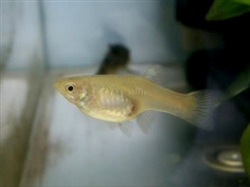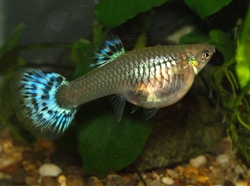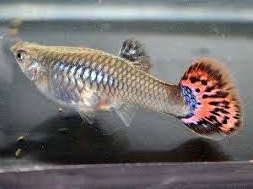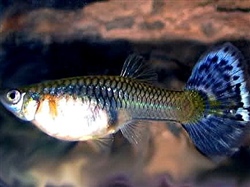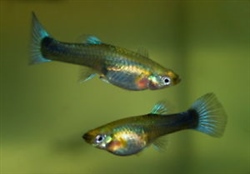Art III
Guppy: a new vision on the Genetics of the Types (1)
RUBRIEK: Guppy Kweek English Translation


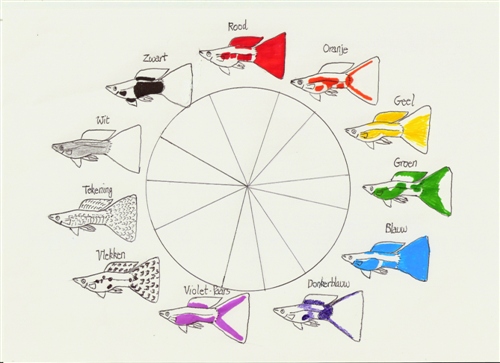
For the scientist, the genotype of a species is important to understand which heredity mechanisms are active and which are applicable in these fish. For the guppy breeder the phenotype of the guppy is important, in order to have a better understanding of what is behind the physical appea-rance of the fish: setting up a kind of genetic passport with the connection between phenotype and genotype, enables him to breed more targeted and to breed more beautiful guppies. The knowledge of genetics may have a practical function and purpose for the guppy breeder, but at the same time it makes the breeding of guppies doubly interesting. A mutual exchange and stimulation takes place between the two knowledge areas. As an 11-year-old child I found this double satisfaction in breeding guppies: (trying to) crack one of the "secrets" of nature, and also breeding beautiful fish.
But in my case, the decisive factor of this double interest lies in the last case: it comes down to "translating" the principles of genetics to the "case" of the guppy. So, not an essay on genetics here, but rather an attempt to explain the gup's genetics passport in manageable language and mecha-nisms. The guppy is at the same time a very grateful subject for this: it is not without reason that it owes its name of million fish or rainbowfish to its extensive variety of shapes and colors. With its rich genetic potential, and the direct connection with the physical effect, it is therefore an excel-lent study object. But this also makes it a difficult study, due to its com-plexity and variety-richness. Hence my contribution here to make this guppy maze a bit more comprehensable and clearer. With this remark: I do NOT follow "the usual ways" of science, but my own lines of thought and insights, from my many years of practice with guppies and my more prag-matic approach. No scientific jargon here, but a new, fresh, DIFFERENT view.
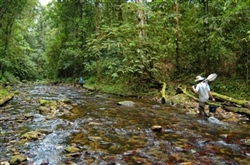
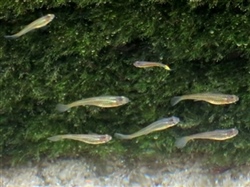
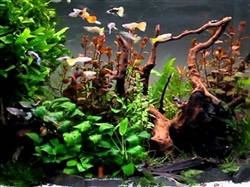
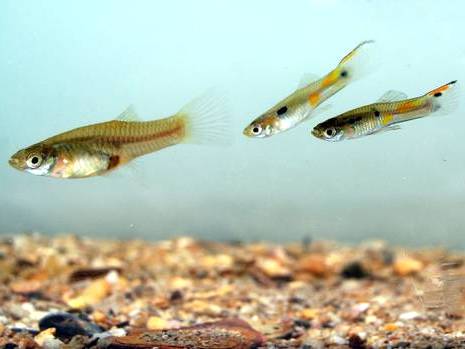
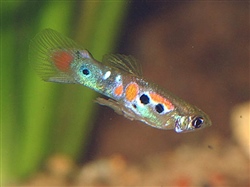
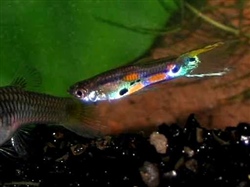
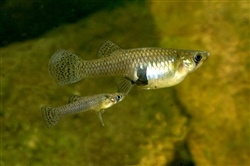
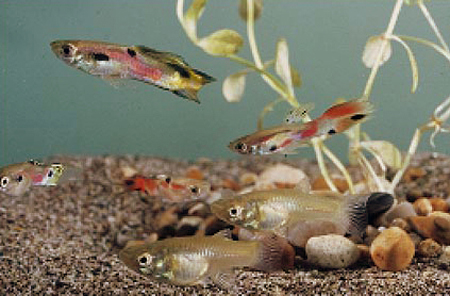
Everything starts with the wild guppy as it developed himself for decades in Central America, and was imported here as an aquarium fish. In 1957, the guppies I had got from someone as a child were not that different from the original wild-caught. Aquarium science was only at the beginning of its development for the majority of citizens at that time. The frame aquariums could still leak, and the technology was still rudimentary: witness a ther-mostat that dit not stop anymore the heater and did boil all the fish in my father's aquarium (an incident that immediately ended his hobby).
Now that guppy in the wild must have had to conform to two contradictory tendencies for centuries: firstly, not being conspicuous with a camouflage color to avoid being eaten as a small fish; and secondly, to yet stand out - for the males than - to impress and seduce females. See: here for more details. The natural selection thus maintained a gup, of which the ground color (!) and the females were gray, and the males with a number of color spots to attract the attention of the females. The habitat of guppies are shallow pools and swamps, where they hunt small larvae and insects; hence their reputation as mosquito larvae killers . I was reminded of this when I found a nephew of the guppy, more specifically the gambusio , in a lake in the south-west of France in the late 1960's. Those mosquitofish lived in the reeds in shallow water where the temperature could reach 36 ° C during the day and drop to 10 ° C at night. Like the guppy, it is an opportunist and survivor, capable of withstanding cloudy or brackish water (with a salt content) and temperature differences. But unlike its cousin, it never made it to become a celebrated aquarium fish due to its lack of color and social behavior towards other fish species.
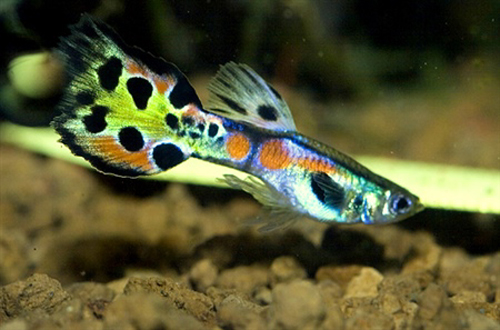
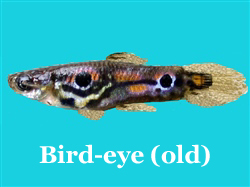



With its entry as an aquarium fish, the guppy was no longer subject to the requirements of natural selection, but was subject to the wishes of the breeder. Initially it did not run that fast, and it was mainly bred on the variability of its caudal fin shape, and various standard shapes were drawn up: the old guptypes as lower sword, top sword, double sword, lyre tail, spatula tail, flag tail, veil tail, triangle tail. The color and the drawings were typified in "lyric" descriptions: the chainguppy with a dark zigzag line on the body; the bird-eye with black round spots; the lace-tail with a dark drawing in the caudal fin that therefore appears a-jour or lace-like. The origin of guppy clubs started in England, so that the first names are also in English: swordtail, lyretail, ......
Both the colors and these drawings show how these traits are "mapped" in the guppy's genes . What I find almost not in the (numerous) publications that have since appeared, is the emphasis that the effect of those genes is threefold : they determine the quantity, and the quality of the pattern (color, drawing), as well as its location . Below an example to make this clearer. It can be seen that both the orange color and the black spots - which I have presented here in 3 gene pairs each time - determine both the intensity and the frequency of color or spots: more genes expresses the trait more. Only one pair of genes: few and pale. Two pairs of genes: many and clear. Three pairs of genes: maximum and emphatic. I have found that EACH color also has a preferred area within which the spots or shades will preferentially occur. After all, with all those breeding products, one could think that any color can appear anywhere at random. But it is precisely the wild and old-fashioned guppies that show that each color will appear first in its preferred areas. The map at the very top of this article shows these preferred locations by color.
Within a species, there is not only the interplay of all these physical (pheno-typic) variations as determined by the distinct genotypes, but also a balance between colors and drawings that are dominant , and colors and graphics that are recessive . "Extensions" of the caudal fin in the form of swords, flags, triangles, ... are dominant on the normal, normal round tail like caudal fin for example. The mixing of the genes ensures that variations arise in nature, but that this takes place within certain limits in order not to endanger the vitality of the species. However, MAN uses DIFFERENT criteria: reproducing on only one particular color or shape characteristic makes the guppies more and more homozygous or pure IN those specific genes, and reproducing recessive genes makes guppies more and more "away" from the normal mixed or wild form. Guppy strains have been bred in this way over the decades.
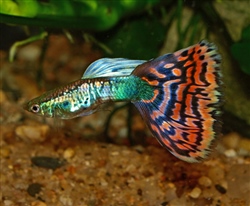
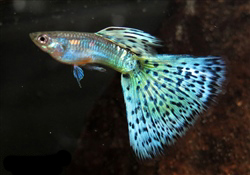
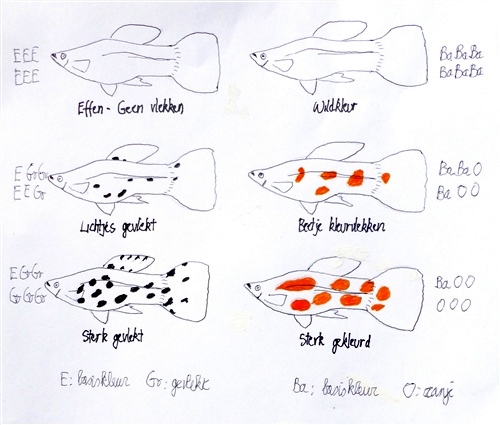
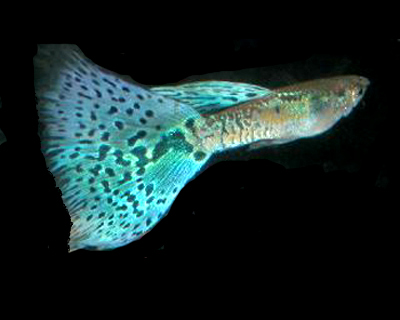

I'm not going to start listing them here, because Philip Shaddock has com-piled this in an excellent way in his Guppy Color Strains . With this contri-bution here, I would rather clarify the genetic mechanisms visually which are behind all these breeding products.
So what "happens" when, for example, one crosses a blue-green lyre-tail guppy with a blue-red mosaic triangle female? (see drawing in the middle below).
We see the red and dark blue colors of the blue-red triangle strain appear in their sons, indicating that these colors are dominant over yellow and green. This is especially noticeable in the tails, which will show all kinds of differences in shape according to the different individuals: from some inscribed and incomplete triangles, to incomplete double swords or even almost single lower swords (and a rare top sword). Triangle and double sword thus form all kinds of intermediate shapes in F1, which will be a combination or a mixture of the caudal fin shapes of both parents. In other words, there is a regression to the mixed form or wild guppy.
It can therefore be noted that this is the opposite way of how the average guppy breeder will approach it: he usually buys a pair from a stock he wants to breed with, and will breed more and more one-sidedly on certain characteristics. Problem: by cultivating more one-sided or more recessive traits, other, undesirable, traits will also emerge more and more, such as: loss of vitality, growing crooked (a common defect), other defects, ...... Often one tries to prevent this problem by breeding with different lines , but sooner or later one will have to introduce "new blood" (= new genes) to avoid inbreeding . When selecting the best fishes, it must also be taken into account that the largest specimens will rarely be those with the most beautiful colors. An additional problem with an all-too-narrow gene com-bination: the places for all these genes are (relatively) limited, so those places are quickly occupied in such homozygous types. It is better to let the gene pool vary within a few variations, than to breed completely identical guppies. Because what one removes cannot come back again: this often results in guppies that meet the standards perfectly in terms of fins, but whose colors are too pale, to even ugly. And I am chronologically ahead of the time here, but it is precisely the loss of that color potential and splendor in the farmed guppies, which has led to a return to the "wild form" (with the endlergup in the 90s , and the latest trend of the ginga kinubali ).
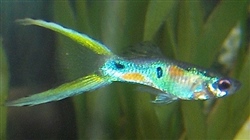
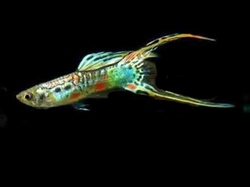

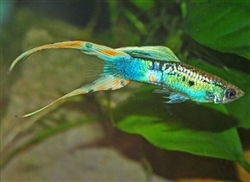
Third problem: the females. It is often suggested that many traits are inherited sex-related ; in particular, that a specific strain trait is attached to the male Y-chromosone. This is indeed the case for a number of rare exceptions, but that is by no means the rule. I think that in most cases there is more question of a masking by the double X chromosome in the females (males have XY and females XX): the traits are there, but are prevented from expressing themselves physically. Why this is necessary, is easy to understand: As egg-bearers , the females must remain discreet with their offspring "inside" to secure the future of the next generation. This reproductive system has both advantages and disadvantages. Advantage: the offspring is better protected than the eggs would be deposited anywhere. Disadvantage: they stay longer in the womb of the mothers, and are therefore more dependent on their mother's fate.
Since the females are ALSO carriers of the genetic traits, but show this much less in their appearance or phenotype, one will have to learn to "read" or extrapolate the genetic code of the females on the basis of these traitsone can still see: the color and shape of their tail and dorsal fins. This takes "eye" and practice, but it is certainly not insurmountable. Below are a few examples that illustrate this much more clearly than 100 descriptions. You can also compare my drawings with the photos of females on the left. The final conclusion is that the female genetics are EVEN important in guppy breeding. By the way, new lines are usually set up by mating selected males with "new" females.


